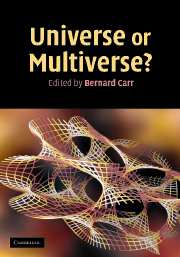Book contents
- Frontmatter
- Contents
- List of contributors
- Preface
- Acknowledgements
- Editorial note
- Part I Overviews
- Part II Cosmology and astrophysics
- 4 Cosmology and the multiverse
- 5 The anthropic principle revisited
- 6 Cosmology from the top down
- 7 The multiverse hierarchy
- 8 The inflationary multiverse
- 9 A model of anthropic reasoning: the dark to ordinary matter ratio
- 10 Anthropic predictions: the case of the cosmological constant
- 11 The definition and classification of universes
- 12 M/string theory and anthropic reasoning
- 13 The anthropic principle, dark energy and the LHC
- Part III Particle physics and quantum theory
- Part IV More general philosophical issues
- Index
- References
7 - The multiverse hierarchy
Published online by Cambridge University Press: 05 July 2014
- Frontmatter
- Contents
- List of contributors
- Preface
- Acknowledgements
- Editorial note
- Part I Overviews
- Part II Cosmology and astrophysics
- 4 Cosmology and the multiverse
- 5 The anthropic principle revisited
- 6 Cosmology from the top down
- 7 The multiverse hierarchy
- 8 The inflationary multiverse
- 9 A model of anthropic reasoning: the dark to ordinary matter ratio
- 10 Anthropic predictions: the case of the cosmological constant
- 11 The definition and classification of universes
- 12 M/string theory and anthropic reasoning
- 13 The anthropic principle, dark energy and the LHC
- Part III Particle physics and quantum theory
- Part IV More general philosophical issues
- Index
- References
Summary
Introduction
Parallel universes are now all the rage, cropping up in books, movies and even jokes: ‘You passed your exam in many parallel universes — but not this one.’ However, they are as controversial as they are popular, so it is important to ask whether they are within the purview of science or merely silly speculation. They are also a source of confusion, since many people fail to distinguish between the different types of parallel universes proposed.
In the big bang model, the farthest one can observe is the distance that light has travelled during the 14 billion years since the expansion began. The most distant visible objects are now about 4 χ 1026 m away. A sphere of this radius defines our observable universe or our horizon volume. We will sometimes loosely refer to this as ‘our universe’, although this may be part of a region which extends much further. In this article, I will survey theories of physics involving what are termed ‘parallel universes’ or ‘multiverses’. These form a four-level hierarchy, allowing progressively greater diversity.
• Level I A generic prediction of cosmological inflation is an infinite ‘ergodic’ space, which contains Hubble volumes realizing all initial conditions — including one with an identical copy of you about 101029 m away.
• Level II Given the fundamental laws of physics that physicists one day hope to capture with equations on a T-shirt, different regions of space can exhibit different effective laws of physics (physical constants, dimensionality, particle content, etc.), corresponding to different local minima in a landscape of possibilities.
• Level III In unitary quantum mechanics, other branches of the wave-function add nothing qualitatively new, which is ironic given that this level has historically been the most controversial.
• Level IV Other mathematical structures give different fundamental equations of physics for that T-shirt.
- Type
- Chapter
- Information
- Universe or Multiverse? , pp. 99 - 126Publisher: Cambridge University PressPrint publication year: 2007
References
- 16
- Cited by



